
Ghana, officially the Republic of Ghana, is a country in West Africa. It lies adjacent to the Gulf of Guinea and the Atlantic Ocean to the south, sharing a border with Ivory Coast in the west, Burkina Faso in the north, and Togo in the east. Ghana covers an area of 239,567 km2 (92,497 sq mi), spanning diverse ecologies, from coastal savannas to tropical rainforests. With nearly 35 million inhabitants, Ghana is the second-most populous country in West Africa. The capital and largest city is Accra; other significant cities include Kumasi, Tamale, and Sekondi-Takoradi. In 1957 Ghana became the first colony in Sub-Saharan Africa to achieve sovereignty, under the leadership of Kwame Nkrumah.
Dermatology is the branch of medicine dealing with the skin. It is a speciality with both medical and surgical aspects. A dermatologist is a specialist medical doctor who manages diseases related to skin, hair, nails, and some cosmetic problems.

Acne also known as acne vulgaris, is a long-term skin condition that occurs when dead skin cells and oil from the skin clog hair follicles. Typical features of the condition include blackheads or whiteheads, pimples, oily skin, and possible scarring. It primarily affects skin with a relatively high number of oil glands, including the face, upper part of the chest, and back. The resulting appearance can lead to lack of confidence, anxiety, reduced self-esteem, and, in extreme cases, depression or thoughts of suicide.

Psoriasis is a long-lasting, noncontagious autoimmune disease characterized by patches of abnormal skin. These areas are red, pink, or purple, dry, itchy, and scaly. Psoriasis varies in severity from small localized patches to complete body coverage. Injury to the skin can trigger psoriatic skin changes at that spot, which is known as the Koebner phenomenon.

A skin condition, also known as cutaneous condition, is any medical condition that affects the integumentary system—the organ system that encloses the body and includes skin, nails, and related muscle and glands. The major function of this system is as a barrier against the external environment.

Lichen sclerosus (LS) is a chronic, inflammatory skin disease, of unknown cause, which can affect any body part of any person, but has a strong preference for the genitals, and is also known as balanitis xerotica obliterans (BXO) when it affects the penis. Lichen sclerosus is not contagious. There is a well-documented increase of skin cancer risk in LS, potentially improvable with treatment. LS in adult age women is normally incurable, although treatment can lessen its effects, and it often gets progressively worse if not treated properly. Most males with mild or intermediate disease, restricted to foreskin or glans, can be cured by either medical or surgical treatment.

Hypertrichosis is an abnormal amount of hair growth over the body. The two distinct types of hypertrichosis are generalized hypertrichosis, which occurs over the entire body, and localized hypertrichosis, which is restricted to a certain area. Hypertrichosis can be either congenital or acquired later in life. The excess growth of hair occurs in areas of the skin with the exception of androgen-dependent hair of the pubic area, face, and axillary regions.
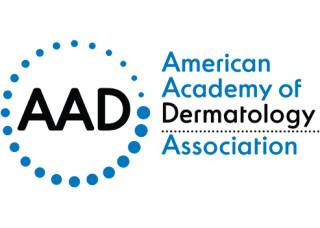
The American Academy of Dermatology (AAD) is a non-profit professional organization of dermatologists in the United States and Canada, based in Rosemont, Illinois, near Chicago. It was founded in 1938 and has more than 20,500 members. The Academy grants fellowships and associate memberships, as well as fellowships for nonresidents of the United States or Canada. Since 1979, the AAD also publishes a monthly medical journal, the Journal of the American Academy of Dermatology.
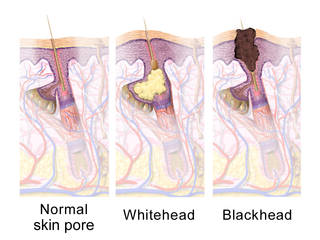
A comedo is a clogged hair follicle (pore) in the skin. Keratin combines with oil to block the follicle. A comedo can be open (blackhead) or closed by skin (whitehead) and occur with or without acne. The word "comedo" comes from the Latin comedere, meaning "to eat up", and was historically used to describe parasitic worms; in modern medical terminology, it is used to suggest the worm-like appearance of the expressed material.
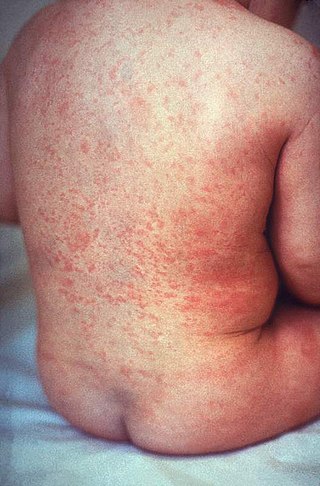
An exanthem is a widespread rash occurring on the outside of the body and usually occurring in children. It is usually caused by a virus, but an exanthem can be caused by bacteria, toxins, drugs, other microorganisms, or as the result from autoimmune disease.
The International League of Dermatological Societies (ILDS) is a non-governmental organization that works closely with the World Health Organization. It was founded in 1935, but because of World War II no congresses were held until 1952. It is governed by the International Committee of Dermatology.

Cheilitis is a medical condition characterized by inflammation of the lips. The inflammation may include the perioral skin, the vermilion border, or the labial mucosa. The skin and the vermilion border are more commonly involved, as the mucosa is less affected by inflammatory and allergic reactions.
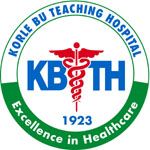
Korle-Bu Teaching Hospital (KBTH) is a public teaching hospital established in 1923 and located in the Ablekuma South District in the Accra Metropolitan District of the Greater Accra Region, Ghana. It is the only public tertiary hospital in the southern part of the country. It is a teaching hospital affiliated with the medical school of the University of Ghana. In 2019, the hospital gained a licence from the Health Facilities Regulatory Agency (HeFRA), after meeting the requirement.
Idiopathic guttate hypomelanosis is characterised by multiple small whitish flat spots. They are typically irregular, well defined and frequently appear on the arms, legs, and faces of older people.
The history of dermatology concerns the development of the practice of researching, defining and treating skin diseases, from ancient times to the present. The field has its origin in the earliest forms of medicine, later becoming a distinct field with its own specialised practitioners and researchers.
Hair follicle nevus is a cutaneous condition that presents as a small papule from which fine hairs protrude evenly from the surface.

The Journal of Investigative Dermatology is a peer-reviewed medical journal covering dermatology. It has been published by Elsevier since 2016 and the editor-in-chief is Erwin Tschachler.
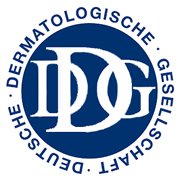
The Deutsche Dermatologische Gesellschaft e.V. is a scientific specialized society for dermatology in Germany. It is a member of the Association of Scientific Medical Societies in Germany (AWMF).
Margaret Y. M. Lartey is a Ghanaian professor of medicine and dermatology, and Dean of the School of Medicine and Dentistry of the University of Ghana. She is known, along with Rashmi Sarkar, for her work in dismissing myths and misinformation about skin care and disease. She was the first female dermatologist to head the Ghana Society of Dermatology.












